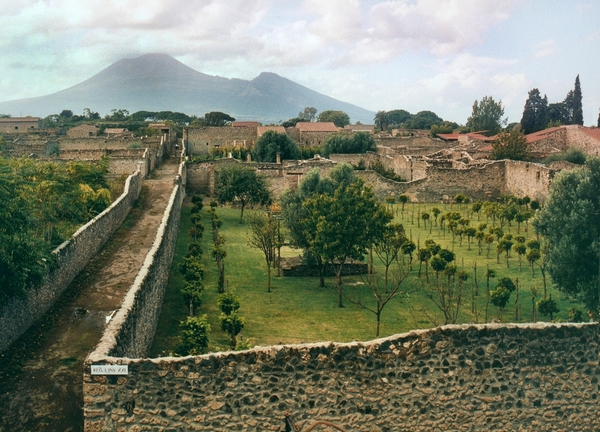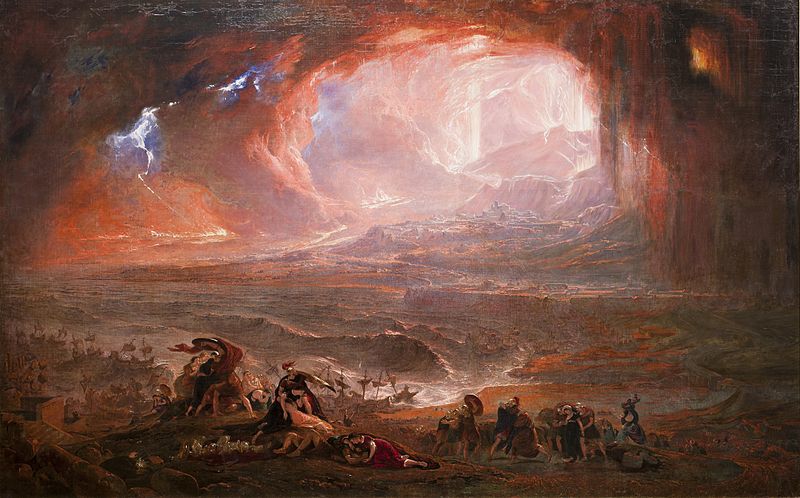Prior to AD 79.
Vesuvius had been a threat to those living near it much earlier than those at Pompeii and Herculaneum would later bear witness to. The Avellino eruption, dating to 2,000 – 1,500 BC had buried local bronze age settlements and this eruption surpassed the brutality of the later famous one.
It has been argued that Vesuvius erupted in some form around 217 BC. As this was the time when Hannibal was wreaking havoc in Italy it wouldn’t have been considered the definitive disaster of the time. There isn’t much evidence pointing to a devastating eruption – the real danger that this time remained with the Carthaginian commander and his relentless pursuit of Roman soldiery.
For those living in Pompeii and around Vesuvius the rewards outweighed any risk they may have been aware of, as the fertile soil allowed for a range of crops to be grown. The only risk anyone in Pompeii had been made aware of was the occasional earthquake. In AD62 there was a serious earthquake which caused damage at both Pompeii and Herculaneum. Seneca’s account of it in a letter to Lucilius detailed the widespread damage to the area and even wrote that it caused the death of 600 sheep.
It’s been argued that the earthquake was a result of the slow build up to the eruption in AD79, although there’s no way anyone at the time could have understood this. Much nearer the eruption it’s likely that smaller tremors would have occurred but it’s not possible that anyone could have read them as a sign of what was to come.
Debates over the date.
The date cited as when the eruption occurred, 24th August AD79, is given as a mainstay. Yet it’s not without question.
In 2018 a scribble was found on a wall in Pompeii. This had been made in charcoal and referred to the middle of October. It’s highly improbable that such a scribble would have survived on the wall for a year. If it did date from AD79 then it undermines any support for the August date of the eruption.
On its own this might be more easily navigated, yet there had already been evidence to question the August date. Carbonised remains of harvested foodstuffs, the type not picked until late autumn also seemed incongruous with August as a date. Even wind patterns were added to the increasingly loud argument for a later date.
The argument for the date of the 24th August is not itself wholly substantive. It’s a reference in a letter 25 years after the event by Pliny, while other authors such as Cassius Dio suggested alternative dates.
A good piece on this debate can be found here.
For the premise of this piece I am going to accept the traditional date of the 24th August. Though perhaps more evidence will be forthcoming in the future for this date to be revised.
The fateful day.
Around midday on 24th August AD 79 Vesuvius erupted, the thermal energy released was the equivalent of 100,000 Hiroshima events. Initially the force and energy went upwards, the ash column eventually reaching a height of around 20 miles. To give some perspective, the cruising altitude of most commercial aircraft is between 5.5 and 7.5 miles.
The column then flattened out and started to cover the sky and after half an hour debris started falling on Pompeii. This took the form of small pieces of pumice and the occasional volcanic bomb, which are larger pieces of molten rock which cool and solidify as they fall.
Those in Pompeii now had an almost surreal landscape in place to deal with and understand. Amidst the roar from the Vesuvius and the spectacle of the eruption itself it was gradually getting darker, with hot objects falling from the sky. The choice was stark – to either leave or seek refuge at home or in a nearby building.

Map of the ash fall from Vesuvius.
The pumice falling on Pompeii did so at a rate of 15cm/h and it’s estimated that a layer of 40cm (16”) would be all that was needed to cause a roof to collapse. By late afternoon structures were failing and buildings were collapsing inwards. For many this was how they met their end. One study[1] estimated that roughly a third of the discovered victims of Vesuvius (345 people) died because of this fallen debris, their remains found amongst rubble often with skulls smashed open.
Those who had avoided this fate may have considered escape, though this was not without risk. For a start it would have been dark, with the ash cloud blotting out any daylight and reducing visibility. The familiar pathways and roads would have been choked by up to 3 metres of hot debris. There would have also been little or no moisture in the air, making breathing uncomfortable and challenging. The familiar paths and routes would have ceased to exist, in place would be a slow trudge across a layer of hot ash, getting higher by the moment.
A short respite came early on the 25th, when the pumice stopped falling, though this was the very definition of the calm before the storm.
The volcanic column which had been continually firing into the sky from Vesuvius had destabilised and started to fail. It collapsed in six instances, each becoming a single pyroclastic density current (PDC) or pyroclastic flow. This is an avalanche of super-heated gas, ash and rocks which rolled down from the volcano.
Of the six PDCs the first three had either not reached Pompeii or had been checked by the north wall of the city. Around dawn (or a few hours after) on the 25th the fourth PDC arrived and caused mass fatalities. Those that followed acted as a coup de grace for anyone left.
Herculaneum.
Herculaneum was spared the initial fall of pumice, the winds that day blowing the cloud over in the direction of Pompeii. Many of the victims of the eruption were found, not in the city, but by the coastline. Their remains were located cramped under arches presumably awaiting rescue by boat. It is likely that these people had been able to make their escape more easily than those in Pompeii, or that they had simply acted more quickly.
Those who had managed to get on a boat before midnight after the eruption had started may have stood a chance. When the ash column started the fall the first PDC, estimated as reaching 500˚C, hit Herculaneum. Death was immediate.
Causes of death.
When casts were originally taken at Pompeii a common pose was noticed, one where the hands were held out in front of the face. A range of explanations were given – for example that people slowly suffocated as a result of the ash or even that they were defending themselves from looters.
However, one explanation seems far more plausible and has been observed elsewhere after volcanic eruptions. It’s called cadaveric spasm, also known as the ‘pugilistic pose’, where victims appear as if suddenly frozen mid-action. Cadaveric spasm is caused by exposure to extreme heat which instantly stiffens groups of muscles[2]. Those at Pompeii and Herculaneum were certainly exposed to high levels of heat and over fractions of a second. The only small mercy in this is that death would have been instantaneous.

The cadaveric spasm as shown within those at Pompeii
Stratification and what it can tell us.
Pompeii was buried by both pumice and the later PDCs. The initial fall of pumice created a layer and above this the successive PDCs each added their own, which allowed archaeologists to allocate victims to a particular event, be it the pumice fall or a specific PDC.
The current figure of 345 victims were located in the pumice layer. The remaining 650 were killed in the later phase of the PDCs (the 4th cited as the main cause of death). This suggests that following the pumice fall many had managed to make it away from the collapsed buildings and into what must have been an unrecognisable landscape.

Table showing the layers at Pompeii (taken from Impact of the AD 79 Explosive Eruption at Pompeii)
Amongst all the horror there is some room for comfort. In her book on Pompeii Professor Mary Beard suggests that Pompeii had a population ranging between 6,400 and 30,000. There are still areas of Pompeii to excavate but based on what has been unearthed it’s estimated that only 2,000 died.
The Pompeii Paradox.
If we were to take the middle figure of 15,000 as a population size for Pompeii this means many people had left prior to the eruption. Experts have argued that in the lead up to the eruption the tremors and such had reminded people of the devastating earthquake in AD62. Perhaps then many had left, either permanently or just for a few months.
This offers something of a paradox, again noted by academics. We treat Pompeii as a city frozen in time with everyone going about their normal business. But what if this wasn’t the case at all? What if Pompeii was a ghost town by the time of the eruption with only a small number of its population left behind? How would that affect our understanding of it?
Think of a family who had decided to leave – they would have taken key valuables and items. After Pompeii their home is excavated, yet what we find isn’t a ‘normal’ residence, but merely a shell of one. Professor Beard continues this idea when writing about how Pompeii may have been further altered by looters and those looking for items there. Tunnels were found during the excavation, presumably by those searching for items to steal. In one instance the body of a boy was found in one such tunnel, presumably the victim of a collapse.
This shouldn’t in any way impinge on the phenomenal amount of knowledge and insight Pompeii has afforded us., but it’s worth keeping in mind. What is certain is that future excavations will only increase this knowledge base further.
The Podcast.
I recorded a podcast on Pompeii. In it I talk about the history of Pompeii up till the eruption and then through the sequence of events, expanding on some of the points mentioned here.
[libsyn_podcast id=10929458]
You can listen to it below, or find the Ancient History Hound podcast wherever you get your podcasts from.
[1] See “Impact of the AD 79 explosive eruption on Pompeii, II. Causes of death of the inhabitants inferred by stratiographic analysis and areal distribution of the human casualties” pg 178
[2] For more information see Lethal Thermal Impact at Periphery of Pyroclastic Surges.
Further reading and sources cited.
Impact of the AD 79 explosive eruption on Pompeii, II. Causes of death of the inhabitants inferred by stratigraphic analysis and areal distribution of the human casualties. Giuseppe Luongo, Annamaria Perrotta, Claudio Scarpati ;Ernesto De Carolis , Giovanni Patricelli , Annamaria Ciarallo
The eruption of Vesuvius of 79 AD and its impact on human environment in Pompeii, by Lisetta Giacomelli, Annamaria Perrotta, Roberto Scandone, Claudio Scarpati
Lethal Thermal Impact at Periphery of Pyroclastic Surges: Evidences at Pompeii, Guiseppe Mastrolorenzo, Pierpaolo Petrone, Lucia Papparlado, Fabio M. Guarino.
Pompeii the life of a Roman Town, Mary Beard



